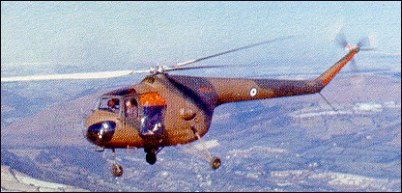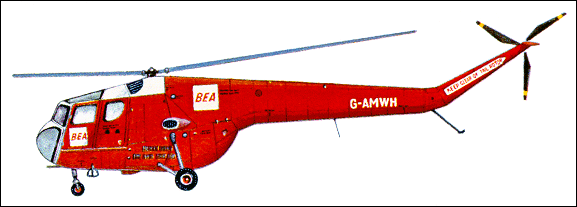
| Bristol Type 171 "Sycamore" 1958 |  |
 |

| Bristol Type 171 "Sycamore" 1958 |  |
 |
|
First post-war British commercial helicopter, the Type 171 was also the first venture by Bristol Aeroplane Co. into the field of rotorcraft. Design studies, under Raoul Hafner, were started in June 1944 and, since no suitable British engine was available at that time, the two Mk.1 prototypes (VL958 and VL963) were built with 450hp Pratt & Whitney 11-985 Wasp Junior radial engines. These were 2-seaters, conforming to Ministry of Supply specification E.20/45; VL958 was first flown on 27 July 1947, and VL963 early in 1948. A Certificate of Airworthiness - the first awarded to a British helicopter - was granted on 25 April 1949. These events were followed by the flight on 3 September 1949 of the one and only Mk.2, built as a 4-seater to specification E.34/46 and powered by a 550hp Alvis Leonides 71 piston engine. This aircraft formed the basis for the first production series, although numerous detail modifications were made to individual machines in these batches, some becoming standard on later production aircraft. The first two production batches, totalling twenty-five aircraft, included one HC Mk.10 ambulance for evaluation by the Army Air Corps; four HC Mk.11's for Army communications work; four HR Mk.12's for RAF search and rescue duties, evaluated by Coastal Command; and two winch-equipped HR Mk.13's for similar trials with Fighter Command. These were collectively to Mk.3 production standard, with 520hp Leonides 173 engines. Two Mk.3A's with improved performance, a shorter nose and extra baggage space behind the engine bay, were completed for British European Airways. Of the remaining dozen machines, five were to Mk.4 standard, also with Leonides 173 engines and having four cabin doors; these were built for the Royal Australian Navy (three HR Mk.50), Royal Australian Air Force (one) and RAF (one HR Mk.14). The remaining seven aircraft were a mixture of Mk.3 and Mk.4 reserved for military trials or civil demonstration. Subsequent output of the Sycamore, as the military Bristol 171 was known, brought the overall total to one hundred and seventy-seven, before production ended in 1959. A further eighty-five HR Mk.14's were built, including a second Sycamore for the RAAF (for use at the Woomera rocket range) and three employed by the Force Aerienne Belge in the (then Belgian) Congo. Seven more Sycamores designated HC Mk.51 were delivered to the Royal Australian Navy, and fifty Mk.52's were supplied to the Federal German forces for miscellaneous duties. Most of these were for Army use, although four were allocated to the Kriegsmarine. The first Sycamores in RAF service were those delivered to No.275 Squadron in April 1953, others joining No.194 Squadron in Malaya in 1954 and No.284 in Cyprus late in 1956. Sycamores have also served in such other trouble spots as Kenya and Aden, and have performed a wide variety of rescue or support duties in addition to liaison work. In the civil field Bristol 171's have performed mountain rescue, traffic patrol and mining survey work, and in August 1955 an aircraft of this type took part in the first British air-to-ground television transmission involving the use of a helicopter. One of the Mk.3 trials aircraft, WT933, was used to part-build the proposed turbine-powered Bristol 203, projected late in 1957 as an 11-passenger helicopter using a high proportion of Bristol 171 components. K.Munson "Helicopters And Other Rotorcraft Since 1907", 1968
Austrian-born Raoul Hafner, who had devoted himself to rotary wing research in the thirties, moved to England before the Second World War and took charge of the helicopter division of the Bristol Aeroplane Co. in 1944. His first aircraft, the Bristol 171 Sycamore, flew on 27 July 1947 with an American Pratt & Whitney R-985 Wasp engine, no suitable British engine being available at the time. It was of metal construction with a three-blade main rotor and was designed as an air taxi (four-five seats) and for military tasks such as air observation and casualty evacuation. In September 1949 the Mk.2 variant flew, powered by a 550hp Alvis Leonides 71 engine. This helicopter was put into production for the British armed forces and among the first 25 built, one (HC Mk.10) was fitted out as an air ambulance, four (HC Mk.11) were intended for Army communications, four (HC Mk.12) for the RAF (liaison, and rescue services) and three (Mk.50) for the Royal Australian Navy (search and rescue). All of these were completed to Mk.3 standard with a Leonides 173 engine. The Bristol 171 Mk.3 civil version, whose capacity was increased to six seats, was also adopted by BEA, which began an experimental service with these helicopters between Eastleigh and Heathrow airport in 1954, which lasted for about two years. In 1950, Bristol produced another civil version, the Mk.4 with four access doors, a longer-stroke landing gear, a bigger baggage compartment and an hydraulic winch. This was primarily intended for search and rescue and air ambulance duties, and was supplied to the RAF (Mk.14), Belgian Air Force (Mk.14B), Royal Australian Navy (Mk.51) and West German Government (Mk.52). Finally, in the mid fifties, the British company began work on development of a turbine-engined Sycamore. This was the Bristol 203 with capacity increased to 11 seats and a larger tail. But this project, using the last two airframes of the Bristol 171, was abandoned when the company was taken over by Westland, although some of its finer points were later incorporated in the Lynx. When production of the Sycamore ended in 1959, 177 had been built. Apart from the RAF, the biggest operator of this helicopter was the German government, which used 50 for the Army and Navy. RAF Sycamores were deployed in various parts of the world where British troops were operating, and in particular played an active part in Malaysia in 1954 and during the trouble in Cyprus towards the end of 1956. G.Apostolo "The Illustrated Encyclopedia of Helicopters", 1984  Late in 1944 the Bristol Aeroplane Company formed a Helicopter Department at Filton and recruited Raoul Hafner from the Airborne Forces Experimental Establishment, where he had been leading a British rotorcraft development team. Drawing on pre-war experience with his A.R.III Gyroplane, Hafner started work on a single-engined four-seat helicopter for both civil and military applications. The lack of sufficiently developed British engine of the required power led to selection of the widely-used 336kW Pratt & Whitney Wasp Junior for the first two Type 171 Mk 1 prototypes, developed to Ministry of Supply Specification E.20/45. The design featured a light alloy cabin section and a stressed-skin tailboom attached to a central engine and gearbox mounting, the rotor head being fitted with three wooden monocoque blades. After extensive component testing, ground running of the completed airframe began on 9 May 1947, and the first flight was made by H. A. Marsh on 27 July. The second aircraft joined the test programme in February 1948 and on 25 April 1949, to facilitate its flight to the Paris Salon, it became the first British helicopter to be granted a civil certificate of airworthiness. An Alvis Leonides radial was installed in the third airframe which appeared in the static park at the 1948 SBAC exhibition at Famborough. Designated Type 171 Mk 2, this helicopter made a successful first flight on 3 September 1949 although a second take-off attempt ended abruptly when the rotor disintegrated. With a strengthened rotor, development flying was resumed while work continued on the assembly of 15 production Mk 3s. VARIANTS Type 171 Mk 3: airframe changes included a shortened nose and an 0.20m increase in cabin width to accommodate three passengers on the rear seat; in order to maintain essential systems in the event of engine failure, the accessory drive was transferred from engine to rotor gearbox; the initial production batch included one Sycamore HC.10 and four Sycamore HC.11 ambulance and communications machines for evaluation by the Army Air Corps, and four Sycamore HR.12 helicopters for rescue duties with RAF Coastal Command; two Mk 3A helicopters, with a freight hold behind the engine bay, were built for British European Airways Type 177 Mk4: main production version, incorporating modifications evolved from Mk 3 experience, including taller landing gear, four cabin doors and the pilot's position moved from port to starboard; deliveries included three Sycamore HR.50 and seven Sycamore HC.51 helicopters for the Royal Australian Navy, three Sycamore Mk 14 aircraft for Belgian air force use in the Congo, and 50 Sycamore Mk 52s for the Federal German Army and Navy; the Royal Air Force received two Sycamore HR.13s and more than 80 Sycamore HR.14s, equipped with winches for air-sea rescue duties, initially with No. 275 Squadron, Fighter Command, which received its first helicopter on 13 April 1953; Sycamores also operated in the light assault and reconnaissance roles in Malaya, Cyprus and Borneo. D.Donald "The Complete Encyclopedia of World Aircraft", 1997 The Bristol 171 was the first postwar British commercial helicopter, and was also the first venture by the Bristol Aeroplane Company into the field of rotorcraft. Work had begun back in June 1944 when a team under Raoul Hafner designed a machine powered by a Pratt & Whitney R-985 Wasp Junior engine. It received the Ministry of Supply Specification E.20/45 and the Mk 1 prototypes were registered VL958 and VL963. The Mk 1 flew in July 1947. The crankshaft lay horizontally, with power transmitted to the vertical driveshaft through a gearbox. The three rotor blades were made of wood with leading edges in hardwood. The Alvis Leonides LE 21 HM engine was fitted to the Mk 2 in a horizontal position with the crankshaft running vertically. This eliminated the lower gearbox which not only saved weight but made the engine more accessible for checking and repairs, and increased the seating from two to five. The Mk 2 had flown in 1948 and a year later the Mk3 appeared with a smaller Alvis Leonides 73 engine. Seating was increased to six. The Mk 3A was bought by British European Airways; it had a slightly superior performance to the Mk3 and greater baggage capacity. In 1950 Bristol produced the 'universal' Sycamore which had extended landing gear and a larger baggage compartment at the rear of the fuselage. It had detachable clamshell doors which made loading quicker and a hydraulic winch which hung directly in front of the door opening and was powered by a pump connected to the drive on the main gearbox. It was a machine ideally suited to search-and-rescue work, air ambulance and passenger carrying. The pilot sat American-style on the right-hand side. Production ended in 1959 with sales to British Commonwealth air forces and also to the Federal German forces and Belgium. In August 1955 a Bristol 171 became the first helicopter to be used in an air-to-surface television transmission. In the mid 1950s Bristol Aircraft Ltd began work on a turbine-powered helicopter using a Mk 3 with an increased fin area. Under the name Bristol 203 it was to be an 11-seat machine and parts from the incomplete 179th and 180th Sycamore airframes were used in the prototype machine, but unhappily the project was abandoned. Bill Gunston "The Illustrated Encyclopedia of Commercial Aircraft", 1980 * * * - The rotor blades were constructed of spruce and ply ribs with a plywood covering and a Hydrulignum spar. - Originally known as the Type 171, the Sycamore was Bristol's first helicopter. - The Sycamore had a simple auto-throttle which the pilot could override. - The last Sycamore version was the HR.Mk 14, which served with Fighter Command's No. 275 Squadron. - In early Sycamores the pilot sat to port, but this was later changed to starboard. - The main production version was the type 177 Mk 4, which had taller landing gear.
|